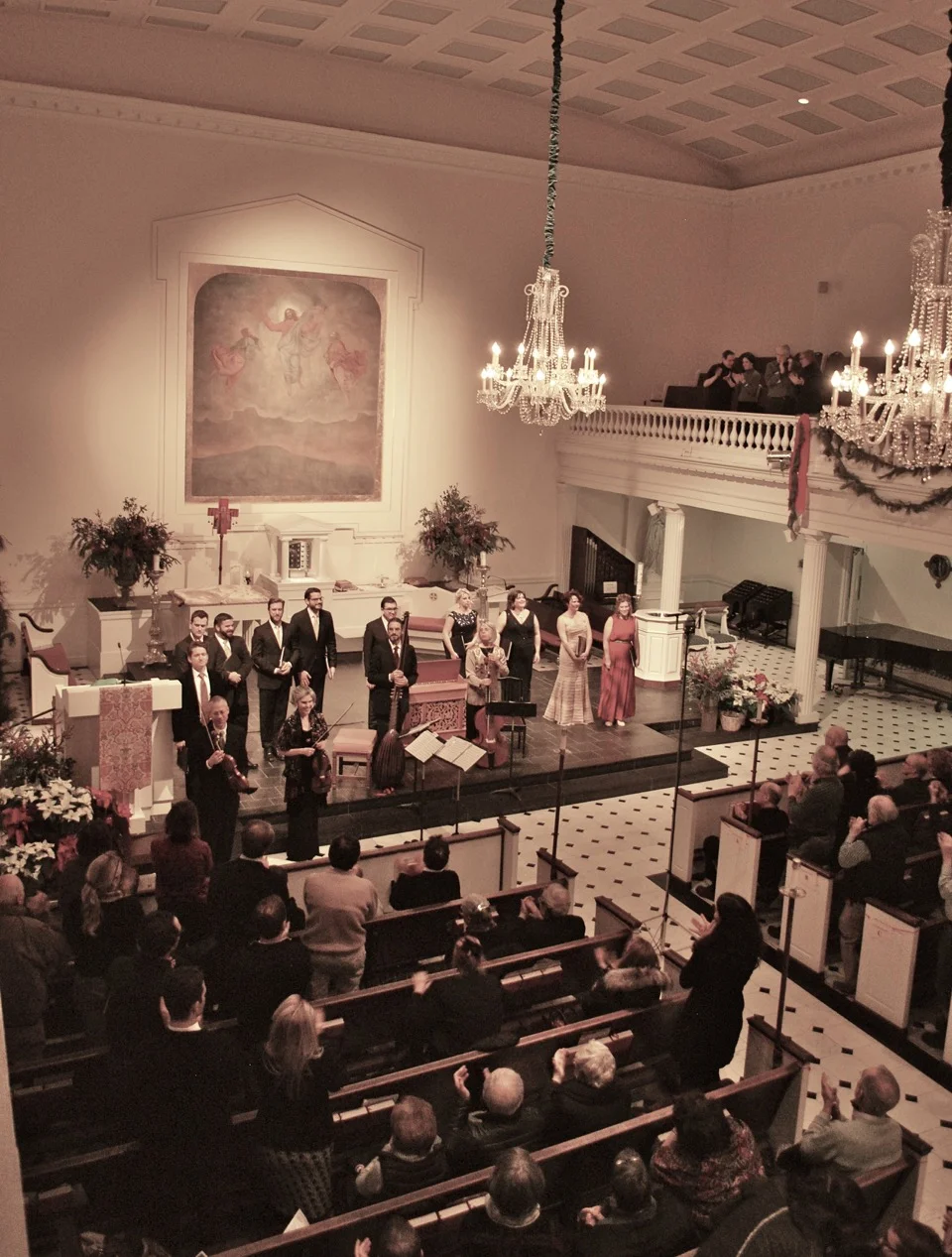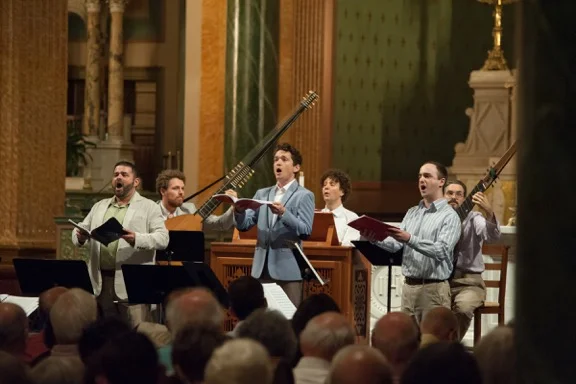Tenet’s instrumentalists broke up the program with substantial works by Nicolò Corradini, Giovanni Gabrieli and Giovanni Battista Fontana, allowing the two superb violinists, Aisslinn Nosky and Beth Wenstrom, to do some duetting of their own. In Gabrieli’s “Sonata XXI con Tre Violini,” the two excellent cornetto players, Alexandra Opsahl and Kiri Tollaksen, were joined by a third, Bruce Dickey, a renowned American virtuoso said to be visiting from his home in Italy.
Read MoreBy Matthew Guerrieri, BOSTON GLOBE
Halfway through the Green Mountain Project’s Monday performance of Claudio Monteverdi’s “Vespero della Beata Vergine,” as Jason McStoots and Owen McIntosh virtuosically tripped through the echoing angelic lauds of “Duo seraphim,” Brian Giebler sidled in at mention of the Trinity, and the song coalesced into triadic solidity. It epitomized the music’s palpable architecture. Monteverdi historically straddled a shift in musical thought, from horizontal counterpoint to vertical harmony. One could hear ideas that once would have made Renaissance waves being stacked into pillars and vaults.
Read MoreThe magnificent Romanesque Revival nave of St. Cecilia Parish in Boston was the venue Monday night for the Vespers of 1610 by Monteverdi. Scott Metcalfe directed 27 of the region’s leading early-music singers and instrumentalists in Tenet/Green Mountain Project’s fourth consecutive performance of a series begun two days earlier at the Church of St-Jean-Baptiste in New York.
Read MoreThe French Baroque composer Marc-Antoine Charpentier never wrote an elaborate choral work in the manner of Monteverdi’s 90-minute “Vespro della Beata Vergine.” But that has not stopped Scott Metcalfe, the early-music violinist and music director of the Green Mountain Project, from piecing together a Vespers score on Charpentier’s behalf.
The project, sponsored by Tenet, the adventurous and excellent early music vocal ensemble in New York, began in 2010 in celebration of the 400th anniversary of Monteverdi’s Vespers. Over the years Mr. Metcalfe has also created alternative Baroque Vespers by assembling individual vocal and instrumental pieces by other composers.
Read MoreClaudio Monteverdi (1567-1643) is the composer who best links the Renaissance with the Baroque periods and what was known as the prima pratica and seconda pratica, aka the “old style” and the “modern style”. The former emphasized clear, smooth polyphony as ordered by the Council of Trent and personified by Palestrina (the text was always to be understood), specified under what circumstances dissonances were to be used, and relied on the cantus firmus (fixed song) technique that was the backbone of Gregorian Chant. But he also made use of the stile moderno, which used monody — a single vocal line, sometimes highly ornamented, over a bass line played by lute, theorbo, organ, harpsichord, or a combination — the type of exclamation that was being used in opera, dance forms, and instrumental interludes. And none of his works exemplifies this connection, this perfect marriage, better than his Vespers of 1610.
Read MoreThe vocal ensemble Tenet, under the direction of Scott Metcalfe, performed a “Vespers for the Feast of St. John the Baptist” as part of its Green Mountain Project on Sunday at St. Paul’s Church in Cambridge. As the bilingually punned name suggests, the project concentrates on the music of Claudio Monteverdi (1567–1643). For this particular program, the group’s nine singers were joined by two violins, a bass violin, two cornetti, four sackbuts, two theorbos, and a positiv organ for a glowing concert of early Baroque sacred delights.
Read MoreThe new Early Music Festival: NYC, which ended last week, gives reason for cautious hope. You can’t be categorical about its prospects one way or the other, because several more or less similar ventures have come and gone in recent years.
But it is also clear that times are changing, and the current climate seems propitious. To a critic who used to lament with some regularity the lack of a vibrant early-music scene in New York, comparable to those in Boston and San Francisco — let alone, say, London and Cologne — the last decade has proved astounding.
Read MoreWe know Monteverdi as, among other things, the composer of the “Vespro della Beata Virgine,” commonly known as the “Vespers of 1610.” It is by many leagues his most renowned piece of sacred music, and one of the great liturgy settings of the 17th century. Yet treating the “Vespers” as a stable, discrete work is deceptive. Since it entered the canon, debates over its nature, purpose, even its actual component parts have arisen, persisting to this day. This provides opportunities for fresh thinking and rediscovery, not only about this piece but also about the context that gave rise to it.
Read More













